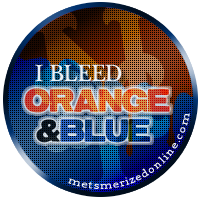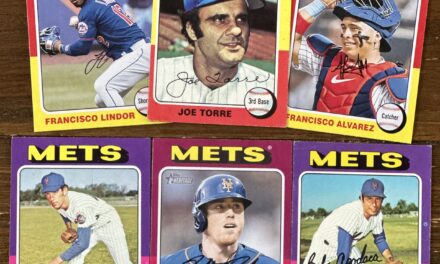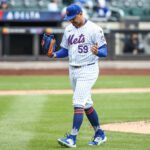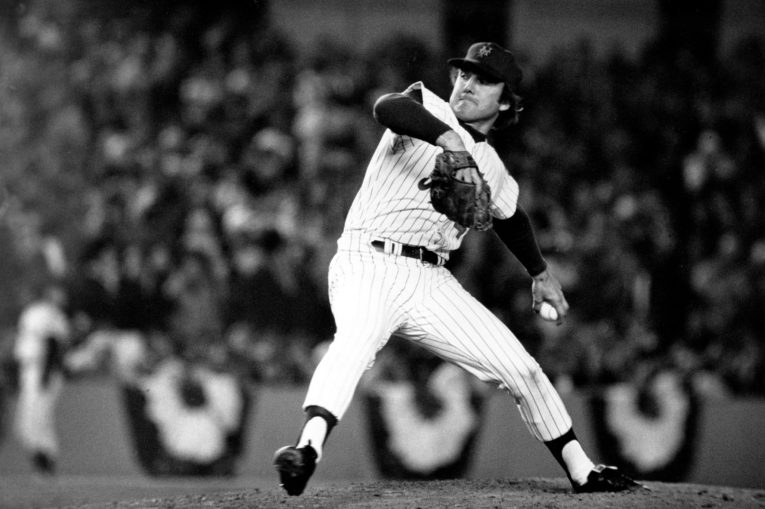
The 1970s was a decade filled with very high highs and very low lows for the still fledgling New York Mets. The nine year-old franchise could not have begun 1970 with more pride as they were defending World Series champions. Memories of a parade down the Canyon of Heroes and shouts of ‘Amazin’ still reverberated around New York when the new decade began. It ended in 1979 with a last place team going nowhere and an empty Shea Stadium.
The Mets of the 1970s won one pennant, saw it’s greatest pitcher win two of his three Cy Young Awards and then later traded, one Rookie of the Year and one All-Star Game MVP. For the first three years following their championship, the Mets had identical 83 win seasons. After the 1971 season, the Mets made a trade that still some call as the worst trade made in franchise history as the Mets traded Nolan Ryan and others for Jim Fregosi.
In 1972, tragedy hit the team as Gil Hodges died of a heart attack after a round of golf. Yogi Berra was named his replacement. That year a young pitcher named Jon Matlack was named Rookie of the Year.
Berra led the team to the NL Pennant in 1973. The Mets were in last place as late as August 14th, until the Ya Gotta Believe Mets stormed to an NL East crown. They beat the favored Cincinnati Reds in the NLCS three games to two before losing the World Series to the Oakland A’s in seven games. Tom Seaver won his second Cy Young Award in 1973.
The NL Champs floundered in 1974 spending only one day of the season above .500. Even Seaver was 11-11 with a 3.20 ERA. The 1975 season was another example of the roller coaster the Mets found themselves in the decade. Yogi Berra was fired on August 6. He was replaced by Roy McMillan. In the span of a week in the autumn, the Mets lost Casey Stengel and owner Joan Payson. On the plus side, Seaver won his third Cy Young Award and Matlack was named MVP of the All-Star game in Milwaukee. Dave Kingman joined the Mets and blasted 36 home runs.
Joe Frazier took over as manager in 1976. Three Mets pitchers had ERAs under 3.00 and Kingman hit 37 homers.
1977 is a year most fans would like to forget. With Joe Torre now at the helm, uneasiness was the order of the day. Due to contracts disputes with the front office and vitriol from the press on a near daily basis, tensions grew between Tom Seaver and the Mets. And on June 15, the impossible happened as Seaver ( and Kingman et al.) were traded away on what became known as The Midnight Massacre. The team never seemed to recover from the loss of its Franchise and finished in last place in 1977, 1978 and 1979. In ’79, the Mets reached the nadir when only 788,905 fans attended 81 home games at Shea, an average of just over 9700. The reeling Mets did not enjoy another season over .500 until 1984.
Here, then, is the Mets All-Decade squad for the 1970s:
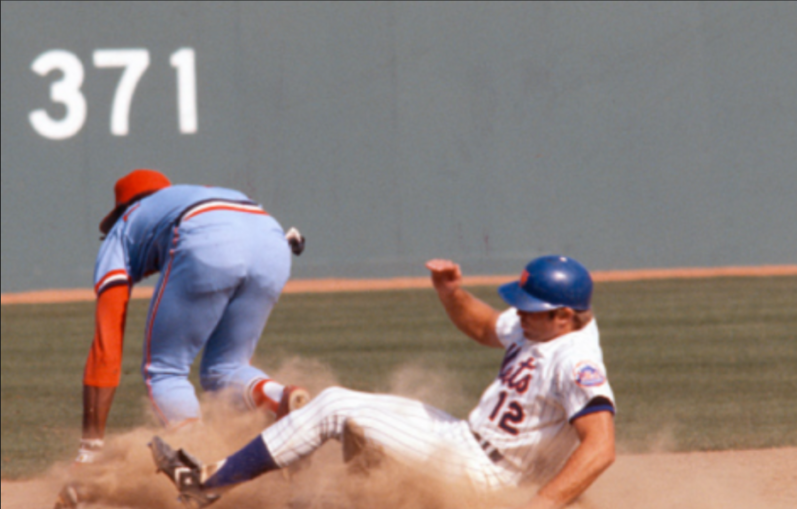
In a close one, John Stearns gets the nod over Jerry Grote. Stearns played in two All-Star games in the decade (four in his career) to Grote’s one. Stearns also was the better hitter and base runner. Stearns had a good season in 1977 with 25 doubles, 12 home runs and 55 RBI. He followed this up with an even better season in 1978. That year, he had 24 doubles, 15 home runs, 73 RBI and 25 stolen bases, which was the most in a single season by a catcher at the time. Although Grote is more noted as a defensive specialist behind the plate, his lack of production of the plate places him second here (he never had more than five home runs and 39 RBIs in any season in the 1970s), but the 1969 championship team member certainly deserves honorable mention.
John Milner, 1B
Sentimentalists might give this one to Ed Kranepool (much as Grote for catcher), but John Milner was one of the best hitters on the Mets in the 1970s. Milner shuttled between first base and the left field during his years in New York, but is most remembered for his solid hitting and better than average fielding. He finished third in Rookie of the Year balloting in 1972 (his team mate, Jon Matlack, was the winner). Milner had a great season in 1973. He had 23 home runs and 72 RBI that year as the cleanup hitter. He followed this up with a 20-home run and 63-RBI season in 1974. After limited play in 1975, Milner had two more good years for the Mets before being traded to the Texas Rangers after the 1977 season.
Overall, Milner had 94 home runs and 338 RBI, both of which were the most of any Mets batter in the 1970s. Certainly, Ed Kranepool, who also saw time in both the outfield and first base, deserves honorable mention.
Felix Millan, 2B
Of all the defensive positions on the diamond, second base has been the spot that the Mets have had the most trouble filling. Through the 70s, Ken Boswell, Felix Millan, and Doug Flynn spent the majority of the time at second with Millan logging the most. He was acquired from the Atlanta Braves after winning two Gold Gloves and appearing twice in the All-Star Game for Atlanta. He spent five years with the Mets and was known for putting the ball in play and being an overall spark plug for the team. He was the first Met to appear in all 162 games in a season in 1975. Also in ’75, he had a then team record 191 hits, a record that stood for 21 years. Millan, unfortunately, is also known for a critical error he made in the 1973 World Series, but overall his body of work merits this distinction. Boswell and particularly Flynn, who was a light-hitter but a fine defensive player, get honorable mention.
Wayne Garrett, 3B
What do Jim Fregosi, Joe Foy and Bob Aspromonte have in common? They were all try-outs and failures for the full-time third base job for the Mets in the early 1970s. It wasn’t until Wayne Garrett came along that the position achieved some stability. After joining the Mets in 1969, Garrett had to wait until 1973 to become the starting third baseman. Never a prolific hitter, he nevertheless help stabilize the left side of the infield for the first part of the seventies and particularly during the pennant winning year of 1973. In ’73, Garrett had career highs in HRs with 16 and RBIs with 58. He hit lead-off that year and remained the starting third basemen for three years. Roy Staiger got most of the playing time in 1976. The honorable mention goes to Lenny Randle who had a productive 1977 before falling off in 1978. Randle’s 1977 saw him finish with a .304 average, five home runs, 27 RBI, 33 stolen bases and a .383 OBP.
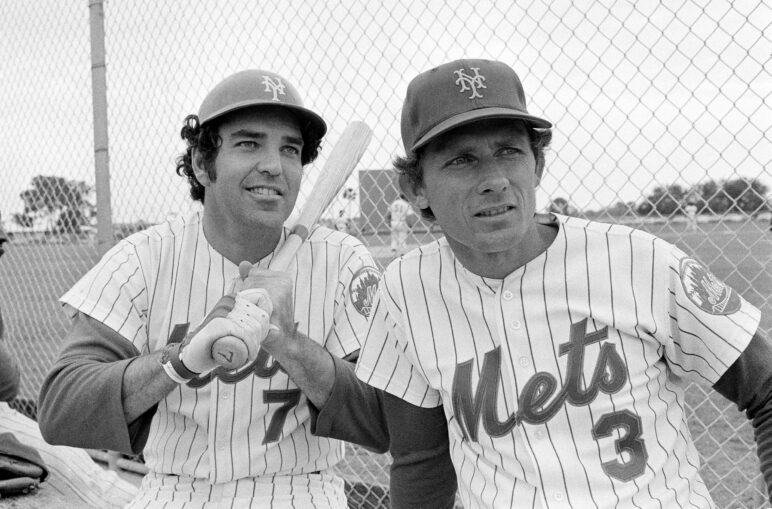
Bud Harrelson, SS
Derrel McKinley Harrelson, or simply Bud as he is better known, was the standard bearer for the shortstop position for most of the early history of the Mets. His playing career for New York spanned 13 years, from 1965-1977, and is by far the longest-tenured shortstop in team history. He got the starting shortstop job in 1967. He was recognized as an outstanding defensive short stop and made the All-Star team in 1970 and 1971. He won a Gold Glove in 1971. Mets fans may also remember the infamous fight that he and Pete Rose had during the 1973 NLCS, which may have given the Mets even more motivation to get back to the World Series—which they ended up doing. His career high in hits was 138 accomplished in 1971 and his best year in RBIs was 1970 when he had 48.
Honorable mention goes to Frank Taveras who had a solid 1979 unlike the majority of his team mates. In ’79, he batted .263 with 26 doubles, one home run and 33 RBI.
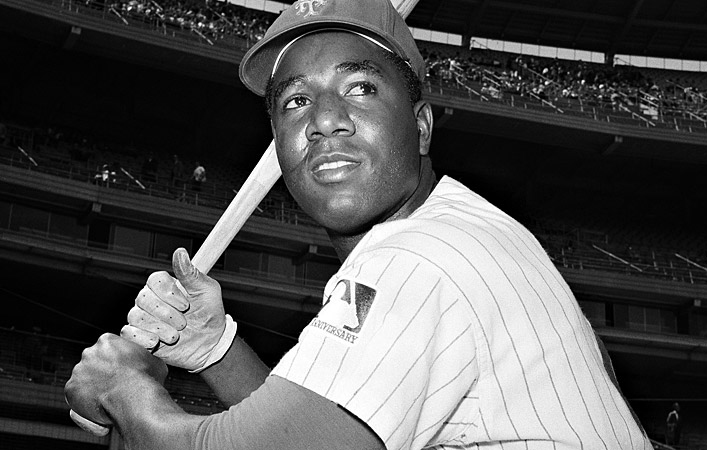
Cleon Jones, LF
An iconic part of their history, Cleon Jones played for the Mets until 1975. After his career year in 1969 when he hit .340, Jones had productive years in the 1970s.
In 1970, Jones batted .277 with 10 home runs and 63 RBI. He then batted .319 in 1971, good enough for seventh in the National League, tied his career high with 14 home runs and drove in 69 RBI.
Jones struggled in 1972 as he saw his average drop to just .245. His five home runs and 52 RBI that year were also poor by his standards He platooned with John Milner that year in left field.
In 1973, Jones bounced back by batting .260 with 11 home runs and 48 RBI. He then batted .300 in the NLCS and .286 in the World Series that year. However, this time, the Mets did not finish the season with a championship.
Jones’ last great year with the Mets was in 1974. He batted .282 with 13 home runs and 60 RBI. He had an injury prone 1975 and did not get along with manager Yogi Berra and was traded to the Chicage White Sox where he finished his career in 1976.
Honorable mention goes to Dave Kingman who was only a Met briefly, but is known for his moon-shot home runs. A pure slugger, Kingman immediately broke Frank Thomas‘ single-season club record with 36 home runs in 1975 and followed up with 37 in 1976. He had nine in 1977 before all of a sudden getting traded during the infamous “Midnight Massacre.”
Lee Mazzilli, CF
A popular Met of the late seventies, Mazzilli was one of the few bright spots on the Mets who finished in last place for a good portion of his first stint with the Mets. He came up in 1976, but his first productive year was in 1978 as he hit for a .273 average, 16 home runs and 61 RBI. However, his best season was a year later in 1979 when he batted a career high .303 with 15 home runs and a career high 79 RBI. He also had 181 hits, 34 doubles, 34 stolen bases and a .395 OBP. He made his only All-Star team that year. Mazzilli also played a solid center field for New York.
Mazzilli played into the early 1980s for the Mets but was traded to the Texas Rangers before the 1982 season for Ron Darling and Walt Terrell. He would return to the Mets for bench strength in August, 1986.
Honorable mention goes to Tommie Agee. In 1970, Agee batted .286 with 24 home runs and 75 RBI. He also had a 20-game hitting streak in April and May. He followed this up with a .285 average, 14 home runs and 50 RBI in 1971. However, he missed some time due to knee injuries. Those same injuries affected Agee in 1972 as well. For that year, his average dropped to .227 and he finished with 13 home runs and 47 RBI. He then got traded to the Astros after the 1972 season for Rich Chiles and Buddy Harris. Certainly, Agee was the standard bearer center fielder in early Mets’ history.
Rusty Staub, RF
Another popular player with the fans who had an all too short time with the Mets was Rusty Staub. Acquired from the Montreal Expos on April 6, 1972, Staub made an immediate impact both offensively and defensively. In 1973, Staub batted .279 with 15 home runs, 76 RBI, and 36 doubles. However, he was clutch in the 1973 NLCS against the Reds. He hit three home runs and drove in five RBI in the series as the Mets won the pennant. In the World Series, Staub batted .423 with one home run and six RBI in 23 at-bats.
In 1974, Staub’s average fell to .258, but he hit 19 home runs and drove in 78 RBI. He followed this up with a .282 average, 19 home runs and a new Mets record 105 RBI, which broke Frank Thomas’ single season record of 94. Staub also had a .371 OBP that year. The thanks he received from the Mets was a poor trade to the Detroit Tigers for Mickey Lolich. Lolich was a disappointment in 1976 in his only season as a Met, while Staub kept hitting with the Tigers, Expos and Rangers.
Honorable mention is tough because the Mets had a plethora of right fielders before and after Staub such as Ken Singleton, Ron Swoboda, Dave Kingman, Mike Vail and Joel Youngblood to name a few. Kingman already has an honorable mention for his left field exploits so the choice here is Ron Swoboda, because he is, well, Ron Swoboda and even though he only played one year in the decade of the 1970s (1970) for the Mets, his overall contribution to the franchise is unforgettable.
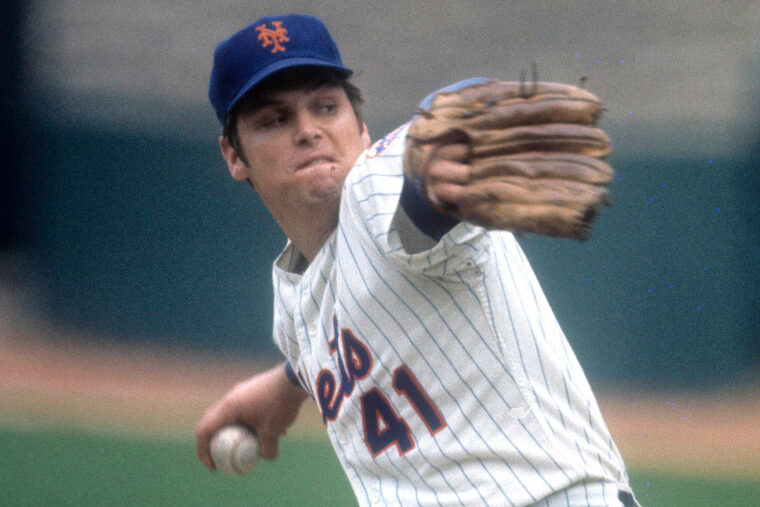
Tom Seaver, RHP
What else can be said about perhaps the greatest right-hand pitcher in history? Summing up Tom Seaver can be done in one stat: he is only one of two pitchers in MLB history with over 300 wins, 3000 strikeouts and an ERA below 3.00, with Walter Johnson the other. In the 70’s, Seaver was in his prime, winning two of his three CYA and going to the All-Star game eight times. Some highlights from the 1970s:
On April 22, 1970, Seaver set a major league record by striking out the final 10 batters of the game in a 2–1 victory over the San Diego Padres. In addition to his 10 consecutive strikeouts, Seaver tied Steve Carlton‘s major league record, at the time, with 19 strikeouts in a nine-inning game. By mid-August, Seaver’s record stood at 17–6 and he seemed well on his way to a second consecutive 20-victory season. But he only won one of his last ten starts, including four on short rest, to finish 18–12. Nonetheless, Seaver led the National League in both earned run average and strikeouts.
In 1971, Seaver led the league in earned run average (1.76) and strikeouts (289 in 286 innings) while going 20–10. However, he finished second in the Cy Young balloting to Ferguson Jenkinsof the Chicago Cubs, due to Jenkins’ league-leading 24 wins, and 325 innings pitched.
Seaver had four more twenty-win seasons (20 in 1971, 21 in 1972, 22 in 1975, and 21 in 1977). He won two more Cy Young Awards (1973 and 1975, both with the Mets). During his tenure with the Mets, Seaver made 108 starts in which he pitched nine or more innings and allowed one run or less. His record in those starts was 93–3 with 12 no-decisions. In seven of the 12 no-decisions, he pitched 10 or more innings. In the 12 no-decisions, he pitched a total of 117 innings, allowing 56 hits and five earned runs, compiling a 0.38 ERA.
In the 1973 NLCS against the Reds, Seaver started Game 1 and pitched seven shutout innings, and even drove in the only Mets run. However, he gave up a home run to Pete Rose in the eighth inning before giving up a walk off home run to Johnny Bench as the Reds won 2-1. In Game 5, Seaver pitched well once again and finally got more run support as the Mets won the game 7-2 and clinched the series to move onto the World Series.
In the 1973 World Series, Seaver started Game 3 and pitched well, but the Mets bullpen did not support him as the A’s offense rallied to win 3-2 in 11 innings. Seaver pitched well in Game 6, but Catfish Hunter simply outpitched him as the Mets lost 3-1.
The less said about “The Midnight Massacre” the better as Seaver was traded to the Cincinnati Reds on June 15, 1977, a dark day in Mets’ history that many fans will never, ever forgive and forget. No honorable mention here as a tribute to his greatness.
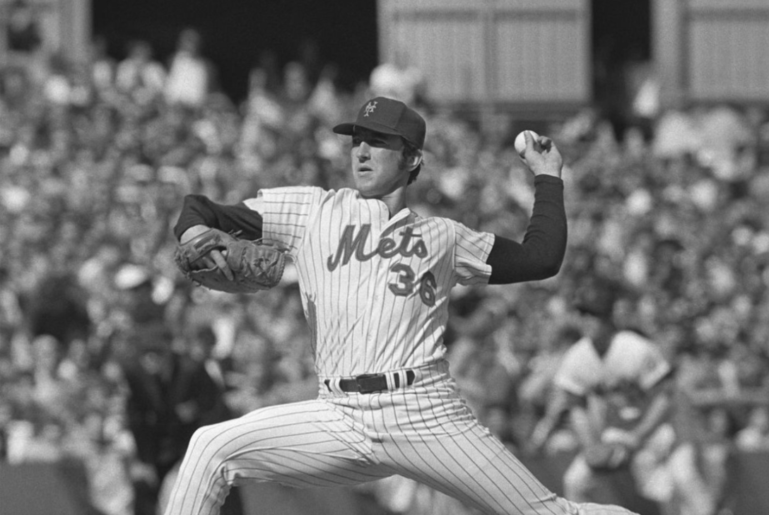
Jerry Koosman, LHP
One of the greatest lefthanders in Mets’ history, Jerry Koosman was a stand-out for the Mets.
In 1970, Koosman went 12-7 with a 3.14 ERA. He then had two unexpected losing seasons in 1971 (6-11, 3.04 ERA) and 1972 (11-12, 4.14 ERA). He also had another losing season when he went 14-15 with a 2.84 ERA in 1973. However, a lack of run support had a lot to do with that. Nonetheless, Koosman pitched well in most clutch situations and became widely known as the go to pitcher when the Mets needed a win.
In the 1973 NLCS, Koosman threw a complete game in Game 2 as the Mets beat the Reds 9-2. In the World Series, Koosman started Game 2, but got hit hard and was removed in the third inning, but the Mets rallied for a 10-7 win. He then won Game 5 as he pitched six and one third scoreless innings as the Mets won 2-0.
In 1974, Koosman went 15-11 with a 3.36 ERA and 188 strikeouts. He followed this up by going 14-13 with a 3.42 ERA in 1975.
1976 turned out to be Koosman’s career season. He went 21-10, with the 21 wins being a career high, and had a 2.69 ERA, as well as a career high 200 strikeouts. He finished second in the NL Cy Young Award voting, losing to Randy Jones.
However, that was Koosman’s last good year as a Met. After going 8-20 with a 3.49 ERA in 1977 and a very underachieving 3-15 with a 3.75 ERA in 1978, Koosman was traded to the Minnesota Twins for Jesse Orosco and Greg Field. Koosman was the last pitcher of the 1969 and 1973 teams to leave the Mets, with Ed Kranepool departing via retirement a year later.
Honorable mention goes to the 1972 Rookie of the Year, Jon Matlack. Although the record books show him to be a .500 pitcher with the Mets (82-81), he pitched many meaningful games in New York and and pitched well in the 1973 post-season.
Tug McGraw, Bullpen
M. Donald Grant first uttered it after a team meeting, but Tug McGraw made it a household phrase in 1973: “Ya Gotta Believe”.
Tug McGraw was already an established closer for the Mets by 1969, but improved during the 1970s. In 1971, he won 11 games in relief, racked up eight saves and had a 1.70 ERA. He followed this up with 27 saves and a 1.70 ERA in 1972.
His 1973 season did not start well, but once he began the “Ya Gotta Believe” rally cry, he completely turned his season around. He ended up recording 25 saves while pitching very well in September as the Mets came out of nowhere to win the NL East division with just a 82-79 record.
He continued to pitch well during the 1973 postseason before battling injuries in 1974. The Mets decided to trade him away after the 1974 season due to health concerns, but the Mets would regret this trade as McGraw continued to pitch well for the Philadelphia Phillies.
Honorable mention goes to Skip Lockwood. Lockwood was the Mets’ primary closer during the late 1970s. Despite being stuck on some bad teams during those years, Lockwood saved 19 games in 1976, 20 games in 1977, 15 games in 1978 and nine games in 1979 before missing the last three months of that season with a shoulder injury.
